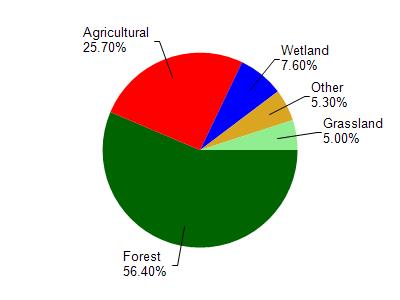Adams
Yes
Yes
No
Fish and Aquatic Life
Overview
Corning Creek drains to the Wisconsin River. The lower 3.5 miles of the creek are classified as a Class I trout stream. The entire stream is designated an Exceptional Resource Water (ERW). A rare aquatic species has historically been found in the creek. There is limited information available for this stream.
Date 2002
Author Cynthia Koperski
Historical Description
Corning Creek, T15N, R6E, Section 31 Surface Acres = 2.8, Miles = 21.7, Gradient = 20 feet per mile
A clear, hard water stream that elbows in a westwardly direction and joins the
Wisconsin River. Sand is the dominant bottom type. It is a spring-fed trout stream with
brook trout found in the headwater portion and brown trout present elsewhere. Although
not as productive as Campbell Creek, it has a sizeable native trout population. Muskrat
are present. The stream was devoid of ice during the February, 1963, aerial groundwater
survey. There is no public land along the stream. Access is possible from four road crossings.
From: Klick, Thomas A. and C.W. Threinen. 1966. Surface Water Resources of Adams County:
Lake and Stream Classification Project. Wisconsin Conservation Department, Madison, WI.
Date 1966
Author Surface Water Inventory Of Wisconsin
General Condition
Corning Creek was assessed during the 2018 listing cycle; new biological (macroinvertebrate Index of Biotic Integrity (IBI) scores) sample data were clearly below the 2018 WisCALM listing thresholds for the Fish and Aquatic Life use. This water as meeting this designated use and was not considered impaired.
Date 2017
Author Ashley Beranek
Condition
Wisconsin has over 84,000 miles of streams, 15,000 lakes and milllions of acres of wetlands. Assessing the condition of this vast amount of water is challenging. The state's water monitoring program uses a media-based, cross-program approach to analyze water condition. An updated monitoring strategy (2015-2020) is now available. Compliance with Clean Water Act fishable, swimmable standards are located in the Executive Summary of Water Condition in 2018. See also the 'monitoring and projects' tab.
Reports
Recommendations
Citizen-Based Stream Monitoring
Collect chemical, physical, and/or biological water quality data to assess the current overall stream health. The data can inform management decisions and may be used to identify impaired waters for biennial lists.
Citizen-Based Stream Monitoring
Collect chemical, physical, and/or biological water quality data to assess the current overall stream health. The data can inform management decisions and may be used to identify impaired waters for biennial lists.
Monitor Fish Community
Corning Creek should be surveyed to determine if rare aquatic elements are still present.
Management Goals
Wisconsin's Water Quality Standards provide qualitative and quantitative goals for waters that are protective of Fishable, Swimmable conditions [Learn more]. Waters that do not meet water quality standards are considered impaired and restoration actions are planned and carried out until the water is once again fishable and swimmable
Management goals can include creation or implementation of a Total Maximum Daily Load analysis, a Nine Key Element Plan, or other restoration work, education and outreach and more. If specific recommendations exist for this water, they will be displayed below online.
Monitoring
Monitoring the condition of a river, stream, or lake includes gathering physical, chemical, biological, and habitat data. Comprehensive studies often gather all these parameters in great detail, while lighter assessment events will involve sampling physical, chemical and biological data such as macroinvertebrates. Aquatic macroinvertebrates and fish communities integrate watershed or catchment condition, providing great insight into overall ecosystem health. Chemical and habitat parameters tell researchers more about human induced problems including contaminated runoff, point source dischargers, or habitat issues that foster or limit the potential of aquatic communities to thrive in a given area. Wisconsin's Water Monitoring Strategy was recenty updated.
Grants and Management Projects
Monitoring Projects
| WBIC | Official Waterbody Name | Station ID | Station Name | Earliest Fieldwork Date | Latest Fieldwork Date | View Station | View Data |
|---|
| 1301400 | Corning Creek | 10031290 | Corning Creek at St. Rd. 13 | 6/6/2014 | 1/1/2015 | Map | Data |
| 1301400 | Corning Creek | 10031291 | Corning Creek at 11th and Fur Lane | 6/6/2014 | 8/19/2020 | Map | Data |
| 5027852 | Unnamed | 10031291 | Corning Creek at 11th and Fur Lane | 6/6/2014 | 8/19/2020 | Map | Data |
| 1301400 | Corning Creek | 10031292 | Corning Creek at 9th Ave. | | | Map | Data |
| 1301400 | Corning Creek | 10033885 | Corning Creek at 13th Ave | 6/28/2011 | 8/19/2020 | Map | Data |
| 1301400 | Corning Creek | 10054706 | Corning Creek | 8/19/2020 | 8/19/2020 | Map | Data |
|

Watershed Characteristics
Corning Creek is located in the Duck and Plainville Creeks watershed which is 195.09 mi². Land use in the watershed is primarily forest (56.40%), agricultural (25.70%) and a mix of wetland (7.60%) and other uses (10.30%). This watershed has 218.59 stream miles, 339.26 lake acres and 9,551.62 wetland acres.
Nonpoint Source Characteristics
This watershed is ranked Low for runoff impacts on streams, Low for runoff impacts on lakes and High for runoff impacts on groundwater and therefore has an overall rank of High. This value can be used in ranking the watershed or individual waterbodies for grant funding under state and county programs.However, all waters are affected by diffuse pollutant sources regardless of initial water quality. Applications for specific runoff projects under state or county grant programs may be pursued. For more information, go to surface water program grants.